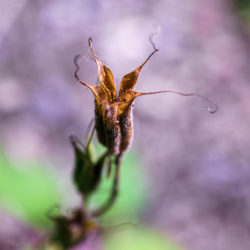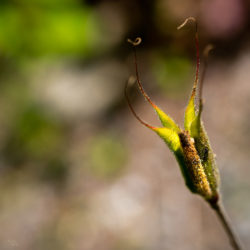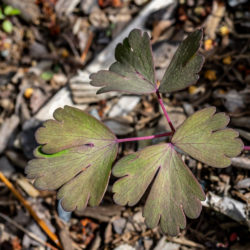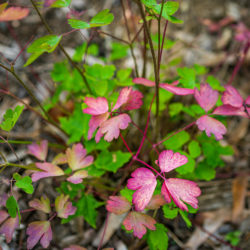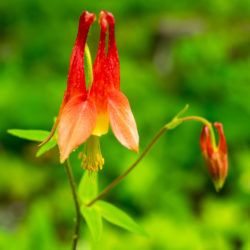Etymology
Aquilegia is Latin for eagle, referring to the spurred tubules that appear similar to eagle talons; canadensis is Latin indicating northern US or Canadian association.
Native Habitat
Lightly shaded to shaded woodlands, in well-drained, alkaline (chalky, calcium-containing) soil that is not too rich or moist.
Garden Uses
Shade-loving, with attractive foliage, and eye-catching blooms in woodland, shade, or border gardens. Naturalizes easily in the right setting.
Overview
Erect, multiple branching perennial, typically 16 to 30 inches tall, with many showy bell-like drooping flowers. Naturally found in lightly shaded to shaded woodlands, in well-drained, alkaline (chalky, calcium-containing) soil, that is not too rich or moist. May tolerate full-sun in Maine. Rich garden soil may stimulate vegetative growth, weak stems and minimal flowering.
Leaves and Stems
Compound leaves are divided into round-lobed threes, which then may be twice-divided into three appearing like large rounded teeth, and growing both from a basal mound and the stem. Light green to blue-green, and semi-evergreen in warmer climates (where temperatures stay above 10 degrees F). Leaves may burn in full sun.
Flowers
Nodding ½-inch blooms with five upward-turning red spurred or tube-like petals, alternating with five smaller yellow petals, and with five spreading, red sepals, and numerous yellow stamens, which hang longer than the petals. Typical bloom is May to June in Maine. Cultivars are available with other bloom colors.
Fruit/Seed
Flowers are followed by five pod-shaped follicles, each approximately 1 inch long. These dry to tan, split when ripe, and expose numerous small black seeds.
Wildlife Associates
Nectar in flower-tubes attracts long-tongued insects (butterflies, hawk-moths) and hummingbirds, while others are attracted to the pollen. Seeds are enjoyed by finches and buntings. Moderately deer resistant. Leaves can be cosmetically damaged by serpentine markings of leafminers, but this native species is less prone than other columbines.
Propagation
Self-seeds easily; seed propagation can be used to form new perennials. Sow seeds by spreading on the surface and lightly tamping in fall or spring. For spring planting indoors, cold-moist stratify for 4 weeks at 40 degrees F. Expect bloom to begin the second year. Readily hybridizes with other columbine species, so keep separated.
Ethnobotanical Uses
North American Indians reportedly crushed the seeds to use as a headache remedy and prepared infusions from the plant as a treatment for heart trouble, poison ivy, kidney problems, headaches, bladder problems, and fever. Many sources recommend against the use of this plant as a home remedy because the plant belongs to a family that includes a number of toxic species.
Garden Location
Performance Hall Garden (see garden map)
Anecdotal Information
Do not overwater; crowns can rot. Trim stems if tidy autumn foliage is desired; leave spent flowers for self-seeding.
Sources
Lady Bird Johnson Wildflower Center
University of Wisconsin Master Gardener Program
Plant Profile by Kate O’Dell

